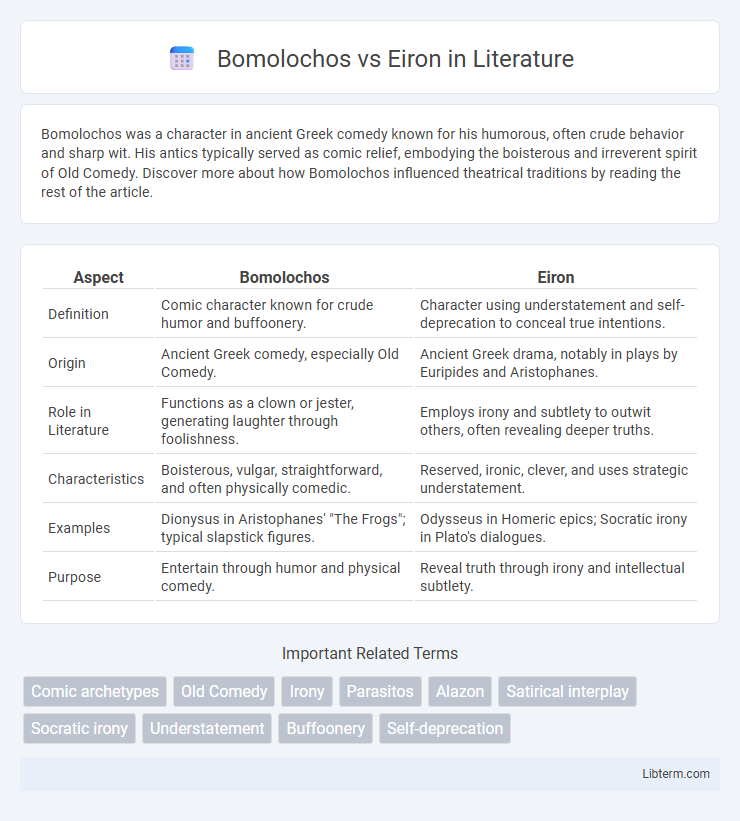Bomolochos was a character in ancient Greek comedy known for his humorous, often crude behavior and sharp wit. His antics typically served as comic relief, embodying the boisterous and irreverent spirit of Old Comedy. Discover more about how Bomolochos influenced theatrical traditions by reading the rest of the article.
Table of Comparison
| Aspect | Bomolochos | Eiron |
|---|---|---|
| Definition | Comic character known for crude humor and buffoonery. | Character using understatement and self-deprecation to conceal true intentions. |
| Origin | Ancient Greek comedy, especially Old Comedy. | Ancient Greek drama, notably in plays by Euripides and Aristophanes. |
| Role in Literature | Functions as a clown or jester, generating laughter through foolishness. | Employs irony and subtlety to outwit others, often revealing deeper truths. |
| Characteristics | Boisterous, vulgar, straightforward, and often physically comedic. | Reserved, ironic, clever, and uses strategic understatement. |
| Examples | Dionysus in Aristophanes' "The Frogs"; typical slapstick figures. | Odysseus in Homeric epics; Socratic irony in Plato's dialogues. |
| Purpose | Entertain through humor and physical comedy. | Reveal truth through irony and intellectual subtlety. |
Understanding Bomolochos: The Comic Clown Archetype
Bomolochos represents the comic clown archetype rooted in ancient Greek theater, characterized by crude humor, physical comedy, and exaggerated foolishness that contrasts sharply with the subtle, witty nature of the Eiron. This archetype engages audiences through slapstick antics and boisterous behavior, often serving as a foil to the Eiron's clever understatement and verbal irony. Understanding Bomolochos enhances comprehension of classical comedic dynamics and their influence on modern comedic characters.
Who is Eiron? The Master of Irony in Ancient Comedy
Eiron is a key figure in Ancient Greek comedy known for his mastery of irony and understatement, often using clever wit to outsmart opponents through subtlety rather than brute force. This character contrasts with Bomolochos, who embodies boisterous and crude humor, relying on slapstick and bawdy jokes. Eiron's refined sarcasm and strategic deception highlight the intellectual sophistication of classical comedic narratives, influencing the development of satire and irony in Western literature.
Bomolochos and Eiron: Origins in Greek Theatre
Bomolochos and Eiron are central comic characters originating from ancient Greek theatre, with Bomolochos often portrayed as the buffoon or clown delivering humor through physical comedy and crude wit. The Eiron contrasts as the clever, understated figure, using irony and subtlety to deceive or outsmart others, representing a sophisticated form of humor rooted in verbal irony. Both archetypes contributed significantly to the development of classical comedy, influencing character dynamics and comedic styles in Greek drama.
Key Characteristics: Bomolochos vs Eiron
Bomolochos is characterized by buffoonery, crude humor, and exaggerated foolishness, often serving as a source of comic relief through boisterous behavior and slapstick antics. Eiron, by contrast, employs subtlety, understatement, and self-deprecating wit, using irony and clever dialogue to outsmart opponents or conceal true intentions. The Bomolochos relies on physical comedy and loudness, whereas the Eiron thrives on verbal irony and strategic ambiguity in ancient Greek drama and literature.
Functions of Bomolochos and Eiron in Dramatic Structure
Bomolochos serves as the comic figure whose primary function is to provoke laughter through buffoonery and crude humor, often embodying slapstick and bodily comedy in dramatic structure. The Eiron contrasts by using understatement, wit, and self-deprecation to subtly undermine or outwit other characters, driving tension and irony within the narrative. Together, these archetypes create a dynamic interplay between overt buffoonery and clever subversion, enriching the comedic complexity of classical drama.
Humor and Wit: Contrasting Styles in Comic Relief
Bomolochos humor relies on exaggerated slapstick and boisterous antics that provoke laughter through physical comedy and crude jokes, emphasizing overt silliness. The Eiron employs subtle wit, understatement, and clever wordplay, often masking intelligence behind a facade of modesty to deliver ironic or satirical humor. These contrasting comic relief styles highlight the Bomolochos' straightforward comedic approach versus the Eiron's nuanced and intellectual humor.
Literary Examples: Bomolochos and Eiron in Classical Works
In classical literature, Bomolochos often appears as the buffoonish character, evident in Aristophanes' comedies where he indulges in crude humor and vulgarity to elicit laughter. In contrast, the Eiron is characterized by irony and understatement, famously represented by Euripides' protagonists who use clever self-deprecation to outwit opponents. The dynamic between Bomolochos and Eiron illustrates the spectrum of humor in ancient Greek drama, from slapstick and boisterous jesting to subtle, ironic wit.
Influence on Modern Comedy: Bomolochos and Eiron Today
Bomolochos, characterized by crude humor and slapstick antics, influences modern slapstick and physical comedy seen in films and television. Eiron, defined by irony, wit, and understatement, shapes contemporary satire, sarcasm, and dry humor in stand-up and scripted comedy. Both archetypes contribute foundational elements to diverse comedic styles, blending exaggerated realism with nuanced verbal irony in modern entertainment.
Symbolic Significance in Social Commentary
Bomolochos represents the crude, often vulgar figure who exposes social absurdities through humor and direct speech, symbolizing a challenge to established norms. In contrast, the Eiron embodies subtlety and understatement, using irony and self-deprecation to critique societal pretensions and power structures. Together, these archetypes serve as symbolic tools in social commentary, reflecting conflicting methods of confronting hypocrisy and injustice within ancient Greek culture.
Bomolochos vs Eiron: Lasting Legacy in Theater and Literature
Bomolochos and Eiron represent contrasting archetypes in classical theater, with Bomolochos embodying the foolish buffoon and Eiron the cunning underdog whose humility masks cleverness. The lasting legacy of Bomolochos lies in its influence on comedic characters that emphasize physical humor and slapstick, foundational to the development of farce and clown roles in both ancient and modern literature. In contrast, the Eiron's subtle wit and ironic self-presentation have deeply shaped satirical and comedic narratives, highlighting intellectual cunning over brute foolishness in storytelling traditions.
Bomolochos Infographic

 libterm.com
libterm.com